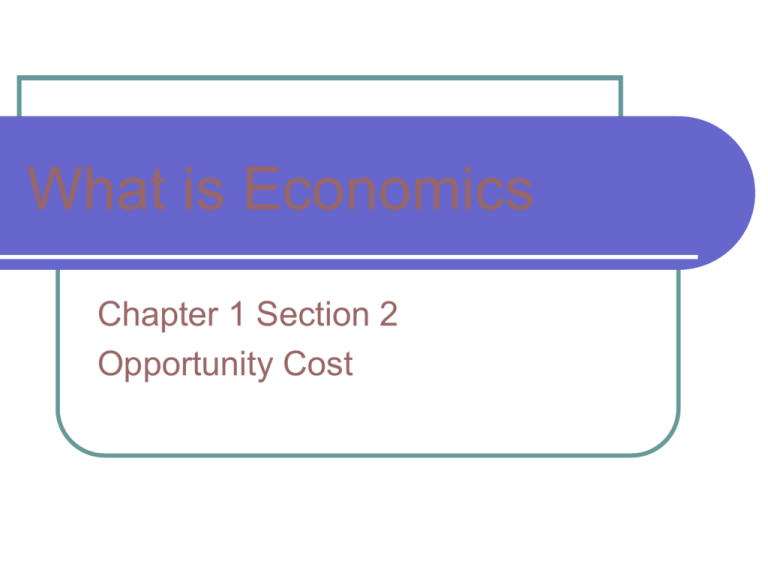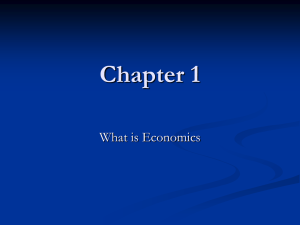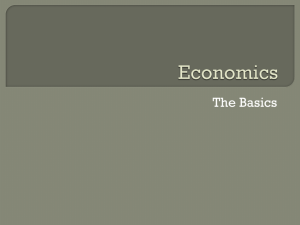What is Economics
advertisement

What is Economics Chapter 1 Section 2 Opportunity Cost What is Economics – Section 1 1. What is the difference between a good and a service? 2. Why is the idea of scarcity a starting point for thinking economically. 3. How is scarcity different from shortage? 4. List and describe the four factors of production. 5. What special advantages does physical capital offer? 6. What role do entrepreneurs play in the economy? What is Economics Objectives: 1. Describe why every decision involves trade-offs. 2. Explain the concept of opportunity cost. 3. Explain how people make decisions by thinking at the margin. What is Economics All human decisions involve trade-offs. The next best alternative to any choice is called an opportunity cost. Many hotels will offer a special service for their guests. Maybe a ticket to the museum that costs $10.00 is sold to the hotel guest for $ 25.00. The guest did not have to wait in line for the ticket and they spent money instead of time to obtain the ticket. What is Economics Trade-offs: Economists point out that all individuals, businesses, and large groups of people – even the government – make decision that involve trade-offs. Trade-offs are an alternative that we sacrifice when we make a decision. Trade-offs are all the alternatives that we give up whenever we choose one course of action over another. What is Economics Individual Trade-offs: Each decision we make involves trade-offs. i.e. If you choose to spend more time at work, you give up watching a movie, spending time with friends, etc. Business Trade-offs: The decisions that businesspeople make about how to use land, labor, and capital resources also create trade-offs. i.e. Farmers who plant broccoli cannot use that land to grow potatoes. What is Economics Society and Trade-offs: Countries also make decisions that involve tradeoffs. Economists simplify their explanations of the trade-offs countries face by using the example of guns and butter. In short, the more butter that a country produces, the fewer guns that the country can produce. This also works vice-versa. What is Economics Defining Opportunity Cost: Usually one alternative is more desirable for a country/business/individual than another. The MOST DESIRABLE alternative given up as the result of a decision is called the Opportunity Cost. What is Economics IF I gave you a choice between these four candy bars… A Which one would you choose? Which one (s) would be your opportunity costs? B C D What is Economics IF I gave you a choice between these four lollipops… Dum-Dum Pops Blow Pops C Tootsie Pops A Which one would you choose? Which one (s) would be your opportunity costs? B Ring Pops D What is Economics IF I gave you a choice between the following… Sleep Late or wake up early for a ski trip? Sleep late or wake up early to eat breakfast? Sleep late or wake up early to study for your Economics test? Which one would you choose? Which one would be your opportunity cost? What is Economics IF I gave you a choice between the following four soft drinks, which one would you choose? A B C D Which one would you choose? Which one (s) would be your opportunity costs? What is Economics Thinking at the Margin: When Economists look at decisions, they point out one more characteristic in addition to opportunity cost. Many decisions involve adding one more unit or subtracting one more unit, such as one minute or one dollar. To understand what it means to think at the margin, picture a piece of paper with a line drawn down the left side. That line separates the space used for writing from extra space on the paper. You could use some of that extra space or you could leave it blank. You are thinking about using one additional unit. What is Economics Thinking at the Margin: In the example of getting up early to study or sleep, you used an “all or nothing” approach. You actually had more options available to you that I did not give you the opportunity to choose from. A. You could have decided to get up one, two, or three hours earlier to study or sleep instead. B. You could have made a decision by looking specifically at how many extra hours to study that morning. When you make a decision about how each extra hour would help your grade means you are thinking at the margin. What is Economics REVIEW: 1. Present three examples that illustrate how all decisions involve trade-offs? 2. Why must the opportunity cost of a decision always be something desirable? 3. How do Economists use the phrase “guns and butter”? 4. What does it mean to “think at the margin”? What is Economics Why do farmers often wait until a rainy day to do their errands in town, while a man in a new suit will forego his errands on the same day? What is Economics Why is a highly talented person who travels a lot willing to hire a chauffeur? What is Economics Why do businessmen often buy full-fare airline tickets while people planning a vacation fly when rates are the lowest? What is Economics Why do Americans today find themselves more pressed for time than their great-grandparents were, despite the fact that we have so many machines and appliances to save us time and labor? What is Economics Why do young women in India cut the grass surrounding the Taj Mahal with kitchen shears (a type of scissors) rather than using lawn mowers? What is Economics Why do movie stars, rock singers, and other high profile people have higher divorce rates than the rest of the American population? What is Economics REVIEW: 1. Examples could be… What shall I do after school? Homework and grades? 2. An opportunity cost must be desirable because there would be no meaningful decision to be made between a desirable option and an undesirable option. What is Economics REVIEW: 3. “Guns and Butter” refers to whether a country chooses to produce more military goods (guns) or more consumer goods (butter). 4. “Thinking at the margin” means making a decision about how much more or less to do. It allows people to evaluate options based on available resources.






